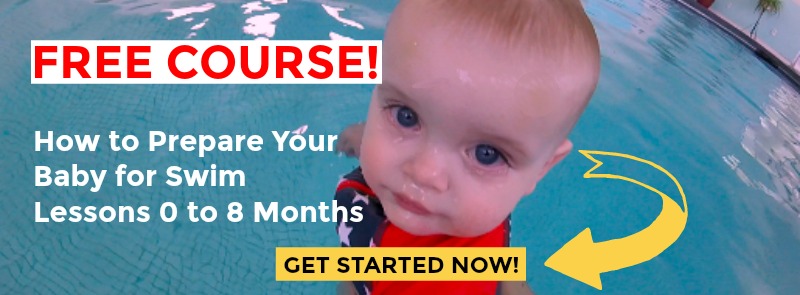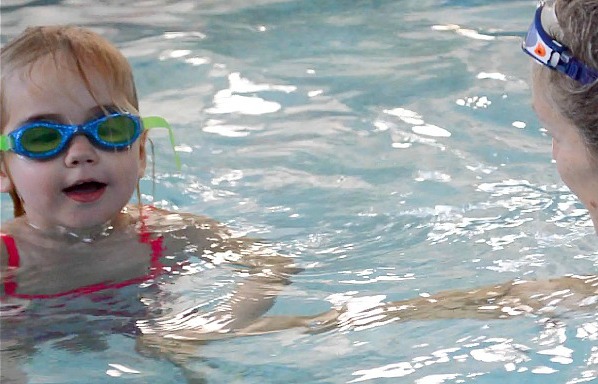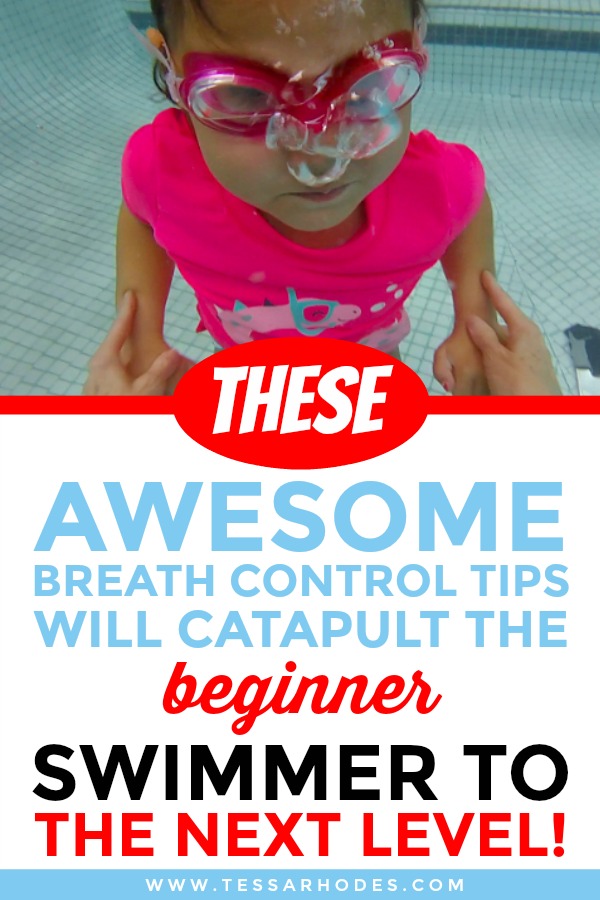
If your child can put her whole face in the water for at least 10 seconds, float on her front, float on her back, and has mastered various other rolls and floats, then she’s ready to learn basic breath control skills (blowing bubbles).

Don’t worry if your child hasn’t given up the nose clip yet. She can start by blowing bubbles with her mouth.
Ultimately, however, blowing bubbles with her nose is the better choice since this option is more efficient at keeping the water out of the nose.
If a swimming pool is not an option, your child can practice this in a bathtub.

Blowing bubbles through the mouth
Before putting her face in the water, have your child practice taking a deep breath in, then exhaling slowly through her mouth. Don’t let her hyperventilate.
To prepare to blow bubbles, have your child sit in a bathtub or on the steps of a swimming pool. Tell her to hold her breath, place her mouth in the water and blow bubbles at the surface.
Assuming that went well, have her do it again. This time with her whole face or head in the water.
Have fun Experimenting with blowing bubbles. Have an underwater birthday party with your child. Blow out the candles on the imaginary cake.
You can also have her start blowing bubbles for a second then stop, then begin again and so on. Or hold her breath for about ten seconds under water, then blow bubbles slowly until she needs to come up for air.
This new skill will enable her to keep her face in the water for longer. Many of my students can stay under the water for twenty to thirty seconds or more.
Blowing bubbles through the nose
Blowing bubbles through the nose can be more challenging for children than blowing bubbles through the mouth.
Demonstrate this first out of the water. Take a deep breath in through your mouth then exhale through your nose. Exhale forcefully enough to allow your child to hear the air pass through your nose.
Now it’s her turn to try it. You can tell her that it’s like blowing her nose with a tissue (watch the video for more specific instructions). And just in case your little one doesn’t know how to blow her nose with a tissue yet, here’s a great tip.
Now have her hum after inhaling through her mouth. Humming will automatically blow air through the nose. Humming is the preferred approach. Easier for young swimmers to grasp than just exhaling through the nose.
Time to try this in the water. Tell her to take a deep breath in through her mouth and start humming. Continue to hum then place her mouth and nose in the water.
The chances are that the bubbles she produces will come from her mouth the first few times. Stress to her that she needs to close her mouth tight to make the bubbles come from her nose.
It will take more practice to blow bubbles through the nose, but in the end, it will be worth it. It is the best way to keep the water out of the nose, especially when rolling over in the water.
More specifically, if she starts to exhale or hum before her nose hits the water, continues to blow bubbles through her nose or hum while under the water and keeps exhaling or humming until after she has safely emerged from the water, this will guarantee a happy nose.
Bobbing
Bobbing is rhythmic breathing while bouncing up and down in the water. Rhythmic breathing is essential when learning formal swimming strokes. It’s best to learn this skill in chest-deep water.
Demonstrate this first. Take a breath in through your mouth then squat down to submerge your whole head. Exhale slowly through your mouth or nose then come right back up for more air. Repeat this sequence three or four more times rhythmically.
Now it’s your child’s turn. See if she can do it on her own first. Some kids will stay under the water too long or end up floating because they don’t plant their feet. Some children wipe their face each time they come up for air.
If she needs help, hold her on your hip and take her down and up. Instructing her each time to take a breath then blow bubbles. Or you can face each other and try it while holding hands.
After some practice, she’ll get the hang of it. With a lot more practice and as long as she has an even exchange of air coming in and going out, she should be able to do this for a minute or more.
At first, however, start with more attainable goals, such as three or five bobs in a row.
What’s next?
Propulsion. Teach your child to propel through the water if you haven’t already covered this. Otherwise, if there doesn’t appear to be any trace of fear in your child when she plays around in the shallow end of a swimming pool, she is ready to be introduced to the deep end.

My mother has been a swim teacher off and on since she was 12, and says blowing bubbles is a waste of time. She says that when the child blows bubbles, they can deflate too quickly which triggers a signal from the brain to the diaphragm to re-inflate the lungs. But when you’re under the water, you are under asphyxia conditions which makes it impossible for anyone to take a breath in the water. The ONLY time you should be blowing bubbles out of your nose is when doing a body roll or a head rotation.
Your mother is correct about the need to re-inflate the lungs. I always encourage breath holding first. I’m glad you brought this up because I never noticed until now that I need to make it clear at the beginning of this blog post that many more skills need to be mastered before introducing bubbles.